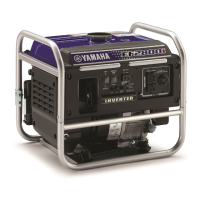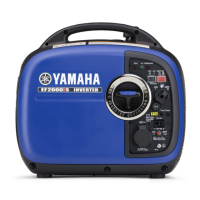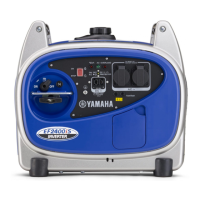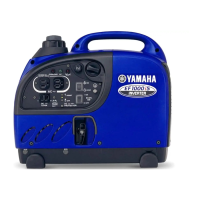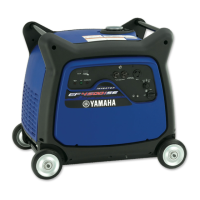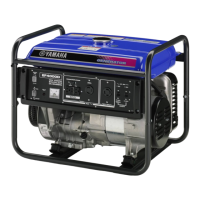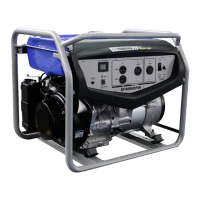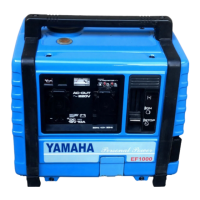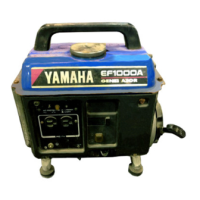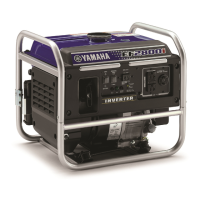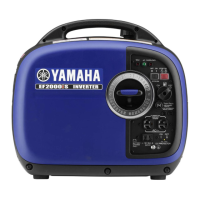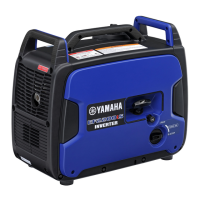Do you have a question about the Yamaha EF4500iSE - Inverter Generator and is the answer not in the manual?
Welcome and overview of the manual's purpose for understanding operation and maintenance.
Explains the meaning of safety alert symbols, warnings, cautions, and notes used throughout the manual.
Emphasizes the importance of reading and understanding the entire manual before operating the generator.
Warns about poisonous carbon monoxide from exhaust fumes and specifies safe operating locations.
Provides safety information on fuel flammability, poisoning, and safe refueling practices.
Alerts users that the engine and muffler can become very hot, posing a burn risk.
Instructions on keeping the machine clear of obstructions to prevent overheating and proper carrying methods.
Safety guidelines to prevent electric shock, including operating in dry conditions and correct grounding.
Notes advising against direct connection to commercial power and parallel connection of multiple generators.
Requires a licensed electrician for safe installation of an isolation switch for building connection.
Guidance on using appropriate, durable extension cords to ensure safe generator use.
Highlights the importance of reading and maintaining all labels for safe operation, including a critical carbon monoxide warning.
Identifies and describes the main external parts of the generator for user familiarity.
Details the various controls, indicators, and receptacles on the generator's control panel.
Explains the function of the engine switch and its positions (ON, STOP, START) for engine control.
Describes the oil warning light, its indication of low oil level, and the resulting automatic engine shutdown.
Explains the AC protector's role in preventing overload and the procedure for resetting it.
Describes the function of the hour meter for tracking usage and the power meter for monitoring output.
Indicates when the engine is running and the generator is producing AC power.
Explains the overload indicator, its triggers, and the steps to resolve an overload condition.
Instructions on how to properly remove and secure the fuel tank cap.
Details the operation of the fuel cock knob for controlling fuel flow to the engine.
Explains the function of the ground terminal for electrical safety and proper grounding.
Describes the operation of the caster lock lever to secure the generator in place.
Safety precautions and steps for adding fuel, checking the level, and using correct gasoline types.
Step-by-step guide for adding engine oil, including recommended types and quantities.
Detailed instructions for battery preparation and installation, emphasizing safety precautions for electrolyte handling.
Essential checks for fuel, fuel line, engine oil, and general operation before starting the generator.
Step-by-step guide for safely starting the generator's engine.
Procedures for safely stopping the generator's engine and turning off fuel flow.
Instructions and warnings for connecting electrical devices to the generator's AC receptacle.
Information on the generator's rated output and application wattage for various loads to prevent damage.
Introduces periodic maintenance and provides a chart of service intervals and required tasks.
Detailed steps for inspecting, cleaning, and replacing the spark plug, including gap and torque specifications.
Notes that carburetor adjustments should be performed by a qualified dealer due to complexity.
Step-by-step guide for draining and replacing engine oil, including safety precautions for hot oil.
Instructions for cleaning and oiling the air filter element to ensure proper engine function.
Procedures for cleaning and inspecting the muffler screen and spark arrester for optimal performance.
Instructions for cleaning or replacing the fuel tank filter to ensure clean fuel delivery.
Information on the sealed battery type, maintenance, and procedures for charging a discharged battery.
Details the recommended voltage and capacity for the generator's battery.
Instructions for replacing the fuse, emphasizing correct amperage and safety precautions.
Steps to remove fuel from the tank and carburetor to prepare the generator for long-term storage.
Procedures to protect the engine from corrosion and store the generator safely in a dry, ventilated area.
Advice on storing the battery properly in a cool, dark, dry place to maintain its charge and condition.
Lists common problems and solutions for when the generator's engine fails to start.
A troubleshooting guide to diagnose and resolve issues where the generator is not producing power.
Provides the physical specifications of the generator, including length, width, height, and weight.
Details the generator's engine specifications, such as displacement, bore, stroke, and fuel type.
Lists the electrical output ratings, including AC output, voltage, frequency, current, and kVA.
Specifies the electrical characteristics of the generator's battery.
Guidance on recording model and serial numbers for parts ordering and security purposes.
Indicates the physical location where the machine's serial number is stamped for identification.
Details the duration of the warranty and the terms for repairs and replacements.
Lists common reasons for warranty claims being denied, such as misuse or lack of maintenance.
Outlines the owner's duties, including proper operation, maintenance, and reporting of defects.
Lists exclusions for parts replaced due to normal wear and tear or routine maintenance.
Details customer responsibilities for costs, incidental costs, and examples of warranty-voiding abuse.
Addresses performing own maintenance and conditions affecting warranty validity.
Outlines dealer responsibilities and the process for transferring the warranty to a new owner.
Lists and defines components related to the exhaust emission control system and their acronyms.
A visual schematic illustrating the electrical connections and components of the generator.
| Brand | Yamaha |
|---|---|
| Model | EF4500iSE - Inverter Generator |
| Category | Portable Generator |
| Language | English |
